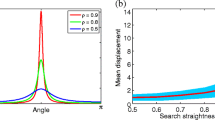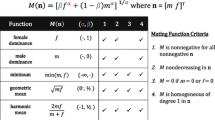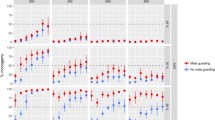Abstract
We propose a new model of permanent monogamous pair formation in zoological populations with multiple types of females and males. According to this model, animals randomly encounter members of the opposite sex at their so-called firing times to form temporary pairs which then become permanent if mating happens. Given the distributions of the firing times and the mating preferences upon encounter, we analyze the contingency table of permanent pair types in three cases: (i) definite mating upon encounter; (ii) Poisson firing times; and (iii) Bernoulli firing times. In the first case, the contingency table has a multiple hypergeometric distribution which implies panmixia. The other two cases generalize the encounter-mating models of Gimelfarb (Am. Nat. 131(6):865–884, 1988) who gives conditions that he conjectures to be sufficient for panmixia. We formulate adaptations of his conditions and prove that they not only characterize panmixia but also allow us to reduce the model to the first case by changing its underlying parameters. Finally, when there are only two types of females and males, we provide a full characterization of panmixia, homogamy and heterogamy.
Similar content being viewed by others
References
Alpern, S., Reyniers, D.: Strategic mating with homotypic preferences. J. Theor. Biol. 198(1), 71–88 (1999)
Alpern, S., Reyniers, D.: Strategic mating with common preferences. J. Theor. Biol. 237(4), 337–354 (2005)
Andersson, M.: Sexual Selection, 2nd edn. Monographs in Behavior and Ecology, vol. 27. Princeton University Press, Princeton (1994)
Bergstrom, C.T., Real, L.A.: Towards a theory of mutual mate choice: Lessons from two-sided matching. Evol. Ecol. Res. 2, 493–508 (2000)
Courtiol, A., Pettay, J.E., Jokela, M., Rotkirch, A., Lummaa, V.: Natural and sexual selection in a monogamous historical human population. Proc. Natl. Acad. Sci. 109(21), 8044–8049 (2012)
Davis, C.S.: Statistical Methods for the Analysis of Repeated Measurements. Springer Texts in Statistics. Springer, New York (2002)
Dietz, K., Hadeler, K.P.: Epidemiological models for sexually transmitted diseases. J. Math. Biol. 26(1), 1–25 (1988)
Etheridge, A.M., Lemaire, S.: Diffusion approximation of a multilocus model with assortative mating. Electron. J. Probab. 16(78), 2122–2181 (2011)
Etienne, L., Rousset, F., Godelle, B., Courtiol, A.: How choosy should I be? The relative searching time predicts evolution of choosiness under direct sexual selection. Proc. R. Soc. Lond. B, Biol. Sci. 281(1785), 20140190 (2014)
Ewens, W.J.: Mathematical Population Genetics. I. Theoretical Introduction, 2nd edn. Interdisciplinary Applied Mathematics, vol. 27. Springer, New York (2004)
Gillespie, J.H.: Population Genetics. A Concise Guide. Johns Hopkins University Press, Baltimore (1998)
Gimelfarb, A.: Processes of pair formation leading to assortative mating in biological populations: Dynamic interaction model. Theor. Popul. Biol. 34(1), 1–23 (1988)
Gimelfarb, A.: Processes of pair formation leading to assortative mating in biological populations: Encounter-mating model. Am. Nat. 131(6), 865–884 (1988)
Gün, O., Yilmaz, A.: Fluid limit for the Poisson encounter-mating model. Preprint, available at: arXiv:1411.7220 [math.PR] (2014)
Hadeler, K.P.: Pair formation. J. Math. Biol. 64(4), 613–645 (2012)
Higgs, P.G., Derrida, B.: Genetic distance and species formation in evolving populations. J. Mol. Evol. 35(5), 454–465 (1992)
Jiang, Y., Bolnick, D.I., Kirkpatrick, M.: Assortative mating in animals. Am. Nat. 181(6), E125–E138 (2013)
Kirkpatrick, M.: Sexual selection and the evolution of female choice. Evolution 36(1), 1–12 (1982)
Lande, R.: Models of speciation by sexual selection on polygenic traits. Proc. Natl. Acad. Sci. USA 78(6, part 2) 3721–3725 (1981)
Mode, C.J.: Some multi-dimensional birth and death processes and their applications in population genetics. Biometrics 18(4), 543–567 (1962)
Mosteller, F.: Association and estimation in contingency tables. J. Am. Stat. Assoc. 63, 1–28 (1968)
Romney, A.K.: Measuring endogamy. In: Kay, P. (ed.) Explorations in Mathematical Anthropology, pp. 191–213. MIT Press, Cambridge (1971)
Taylor, C.E.: Differences in mating propensities: Some models for examining the genetic consequences. Behav. Genet. 5(4), 381–393 (1975)
Acknowledgements
We are indebted to A. Courtiol for introducing us to Gimelfarb’s work on encounter-mating and for suggesting interesting problems. We also thank F. Rezakhanlou and P. Diaconis for valuable comments and discussions. O. Gün gratefully acknowledges support by DFG SPP Priority Programme 1590 “Probabilistic Structures in Evolution”. A. Yilmaz is supported in part by European Union FP7 Marie Curie Career Integration Grant no. 322078.
Author information
Authors and Affiliations
Corresponding author
Rights and permissions
About this article
Cite this article
Gün, O., Yilmaz, A. The Stochastic Encounter-Mating Model. Acta Appl Math 148, 71–102 (2017). https://doi.org/10.1007/s10440-016-0079-9
Received:
Accepted:
Published:
Issue Date:
DOI: https://doi.org/10.1007/s10440-016-0079-9
Keywords
- Population dynamics
- Pair formation
- Encounter-mating
- Assortative mating
- Random mating
- Panmixia
- Homogamy
- Heterogamy
- Monogamy
- Mating preferences
- Mating pattern
- Contingency table
- Multiple hypergeometric distribution
- Simple point process
- Poisson process
- Bernoulli process




